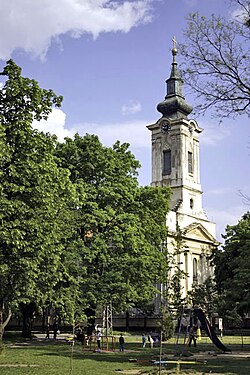Žabalj: Difference between revisions
JJMC89 bot (talk | contribs) Migrate {{Infobox settlement}} coordinates parameters to {{Coord}}, see Wikipedia:Coordinates in infoboxes |
No edit summary |
||
| Line 27: | Line 27: | ||
| area_blank1_km2 = 400 |
| area_blank1_km2 = 400 |
||
| area_footnotes = <ref>{{Serbian municipalities 2006}}</ref> |
| area_footnotes = <ref>{{Serbian municipalities 2006}}</ref> |
||
| elevation_m = 72 |
|||
| population_footnotes = <ref>{{Serbian census 2011}}</ref> |
| population_footnotes = <ref>{{Serbian census 2011}}</ref> |
||
| population_as_of = 2011 census |
| population_as_of = 2011 census |
||
Revision as of 16:38, 17 February 2018
Žabalj
Жабаљ | |
|---|---|
Town and municipality | |
 Orthodox church in Žabalj | |
 Location of the municipality of Žabalj within Serbia | |
| Coordinates: 45°22′N 20°04′E / 45.367°N 20.067°E | |
| Country | |
| Province | Vojvodina |
| District | South Bačka |
| Settlements | 4 |
| Government | |
| • Mayor | Branko Stajić |
| Area | |
| • Municipality | 400 km2 (200 sq mi) |
| Elevation | 72 m (236 ft) |
| Population (2011 census)[2] | |
| • Town | 9,107 |
| • Municipality | 25,777 |
| Time zone | UTC+1 (CET) |
| • Summer (DST) | UTC+2 (CEST) |
| Postal code | 21230 |
| Area code | +381 21 |
| Car plates | NS |
| Website | www |


Žabalj (Serbian Cyrillic: Жабаљ) pronounced [ʒǎːbaʎ] is a town and municipality located in the South Bačka District of the autonomous province of Vojvodina, Serbia. Žabalj town has a population of 9,107, and Žabalj municipality 25,777. It is located in southeastern part of Bačka, known as Šajkaška.
Name
Its name came from the Serbian word "žaba" / жаба ("frog" in English). In Serbian, the town is known as Žabalj (Жабаљ), in Hungarian as Zsablya or Józseffalva (between 1886 and 1919), in German as Josefdorf, and in Croatian as Žabalj.
History
This article needs additional citations for verification. (December 2009) |
Žabalj was first mentioned in 1514 as a fortress captured by György Dózsa. During the Ottoman rule (16th-17th century), it was populated by ethnic Serbs. In the 18th and 19th century, Žabalj was part of the Habsburg Military Frontier (Šajkaš Battalion). First church in Žabalj was mentioned in 1720, but it was later razed. Present-day Orthodox church dedicated to Saint Nicholas was built in 1835. In 1901, the Catholic church was built as well.
Since 1918, Žabalj was part of the Kingdom of Serbs, Croats and Slovenes and subsequent South Slavic states. During the Hungarian Axis occupation, in 1942 raid, 666 inhabitants of the town were murdered, of whom 355 were men, 141 women, 101 children, and 69 old people. By nationality, victims included 614 Serbs, 28 Jews, 23 Romani, and 1 Hungarian.
Inhabited places
Žabalj municipality encompasses the town of Žabalj, and the following villages:
Ethnic groups (2002 census)
This article needs to be updated. (January 2012) |
The population of the Žabalj municipality:
- Serbs (86.25%)
- Rusins (5.11%)
- Romani (2.79%)
- Hungarians (1.1%)
All settlements in the municipality have an ethnic Serb majority.
Historical population of the town
- 1961: 7,457
- 1971: 7,851
- 1981: 8,503
- 1991: 8,766
Politics
Seats in the municipal parliament won in the 2004 local elections: [1]
- Serbian Radical Party (12)
- Democratic Party (5)
- Strength of Serbia Movement (3)
- Serbian Renewal Movement (2)
- G17 Plus (2)
- Coalition "Victory" (2)
- Alliance of Serbs in Vojvodina (2)
- Socialist Party of Serbia (2)
- Democratic Party of Serbia (1)
Gallery
-
Monument of the 1942 raid victims near Žabalj
-
The Catholic Church
See also
- Šajkaška
- South Bačka District
- List of places in Serbia
- List of cities, towns and villages in Vojvodina
References
- Slobodan Ćurčić, Broj stanovnika Vojvodine, Novi Sad, 1996.
- Zvonimir Golubović, Racija u južnoj Bačkoj 1942. godine, Novi Sad, 1991.
- Dr Dušan J. Popović, Srbi u Vojvodini, knjiga 1, Novi Sad, 1990.
References
- ^ "Municipalities of Serbia, 2006". Statistical Office of Serbia. Retrieved 2010-11-28.
- ^ "2011 Census of Population, Households and Dwellings in the Republic of Serbia: Comparative Overview of the Number of Population in 1948, 1953, 1961, 1971, 1981, 1991, 2002 and 2011, Data by settlements" (PDF). Statistical Office of Republic Of Serbia, Belgrade. 2014. ISBN 978-86-6161-109-4. Retrieved 2014-06-27.






